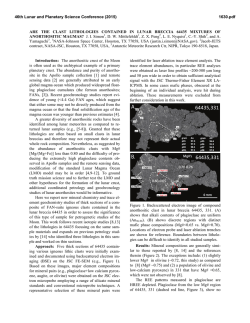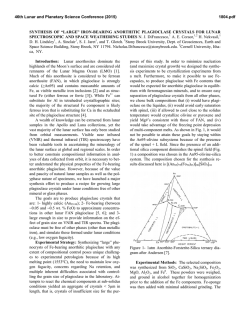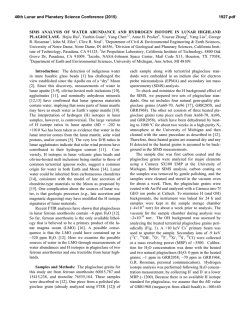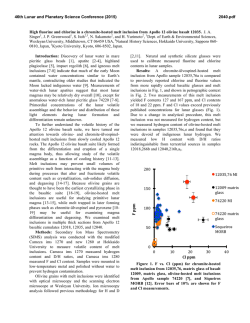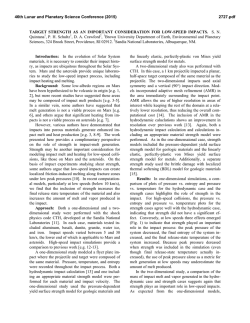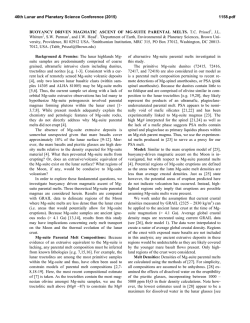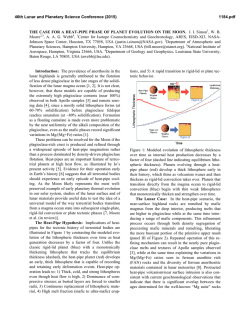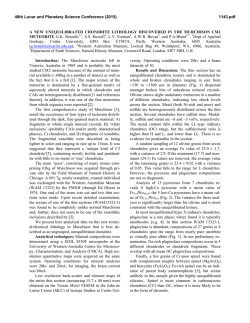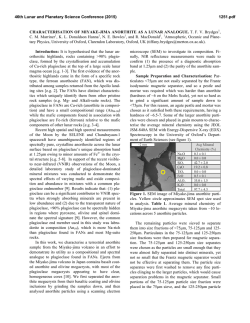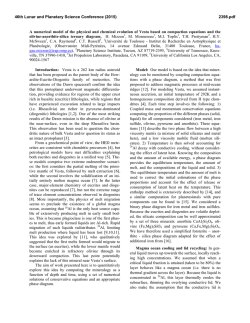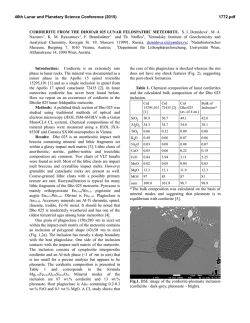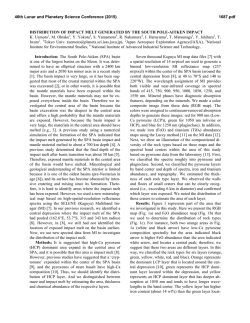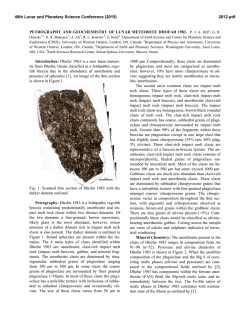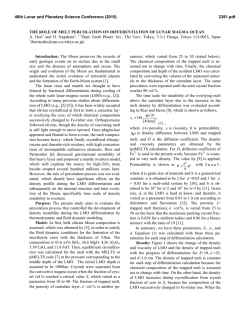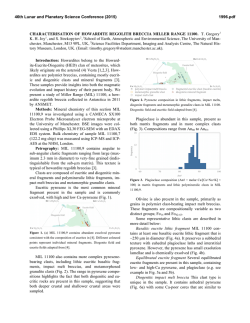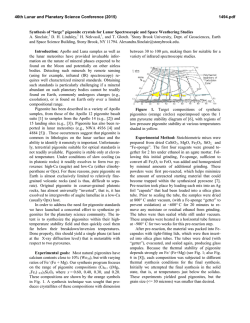
crystal accumulation in a 4.2 ga lunar impact melt from a pre
46th Lunar and Planetary Science Conference (2015) 1755.pdf CRYSTAL ACCUMULATION IN A 4.2 GA LUNAR IMPACT MELT FROM A PRE-IMBRIUM BASIN IN THE PKT: PETROLOGY AND MINERAL CHEMISTRY OF 67955. M. D. Norman1 and L. A. Taylor2, 1 Research School of Earth Sciences, The Australian National University, Canberra ACT 0200 Australia ([email protected]), 2Planetary Geosciences Institute, Dept. of Earth & Planetary Sciences, The University of Tennessee, Knoxville TN 37996 USA ([email protected]). Introduction: The compositions, petrology, and ages of lunar melt rocks provide important information about physical processes associated with large impact events and the impact history of the early Solar System. Two of the outstanding problems relevant to lunar impact history and processes concern the duration of the basin-forming epoch and the extent to which melt sheets associated with lunar basins undergo crystalmelt fractionation after emplacement. Fractional crystallization of large-volume impactmelt sheets has been invoked to explain some of the compositional and petrological diversity observed in the lunar highlands crust [1-4]. However, to date there has been little geochemical or petrological support for this idea from lunar samples. Here we present evidence for crystal-melt fractionation of a large-volume of impact melt from the petrology and mineral-chemistry of sample 67955. Combined with previous determinations of a 4.2 Ga crystallization age for this impact-melt [5,6], our study provides direct evidence for fractional crystallization of impact melt sheets associated with at least some basin-scale impacts on the Moon. Petrography and mineral chemistry: Sample 67955 is a breccia consisting of lithic clasts of a crystalline noritic anorthosite lithology in a partially recrystallized, cataclastic matrix. It was collected from Outhouse Rock on the rim of North Ray crater to sample a while lithic clasts in the dark-matrix host breccia. Early petrologic studies proposed a plutonic origin for the noritic anorthosite lithology [7,8]. Subsequent studies classified 67955 as a feldspathic granulite [9,10], emphasizing its origin as an impact breccia. Fig. 1. Photomicrographof the 67955 noritic anorthosite. Field of view is 1 mm wide. The noritic anorthosite clast we studied has a holocrystalline, slightly annealed meta-igneous texture consisting of pyroxene oikocrysts surrounding subhedral to euhedral olivine and plagioclase (Fig. 1). The unbrecciated igneous texture and abundant Fe-metal with high siderophile element contents [6] show that it formed by crystallization of an impact melt rather than as an endogenous cumulate. Major-element compositions of the primary phases vary within narrow ranges that fall within the Mg-suite field [5]. Trace-element concentrations and diagnostic ratios, such as Sr/Ba and Eu/Al, in the plagioclase are also mostly similar to those measured in plagioclase from lunar Mg-suite cumulates, with a few grains trending toward compositions observed in ferroan anorthosites (Fig. 2). Fig. 2.Trace element compositions of 67955 plagioclase compared to FAS and Mg-suite. Trace-element evidence for crystal accumulation: Trace-element compositions of the plagioclase and pyroxene imply crystallization from a melt that was strongly enriched in incompatible elements relative to the whole rock composition, implying formation of the noritic anorthosite as a crystal cumulate. Application of mineral-melt distribution coefficients to REE compositions of the 67955 plagioclase and pyroxene imply parental melt compositions that are strongly enriched in REE with higher LREE/HREE and deep negative Eu anomalies (Fig. 3). Systematic differences between melt compositions inferred from the 67955 plagioclase vs. the low-Ca pyroxene (Fig. 3) may be due to subsolidus equilibration but the conclusion that the rock crystallized from a melt that was highly enriched in incompatible elements appears robust. Middle REE (Nd, Sm, Gd) are not strongly affected by subsolidus requilibration as their 46th Lunar and Planetary Science Conference (2015) 1755.pdf mineral-mineral partition coefficients are close to unity. Forced partitioning during closed system crystallization and kinetic disequilibrium in surface layers adjacent to growing crystals are unlikely explanations for these trace-element enrichments in the 67955 plagioclase and pyroxene. Quantitative modeling shows that fractional crystallization of the 67955 whole-rock composition cannot produce the range of Ba, Sr, Ti, and La compositions of the 67955 plagioclase. Rather, the models require an initial melt composition that was strongly enriched in these elements, and they suggest that fractional crystallization became less efficient as crystallization proceeded (Fig 4). The contrast between the inferred parental melt composition and the whole rock composition of 67955 implies that this lithology formed as a crystal-cumulate complementary to an incompatible element-enriched residual melt. Together with recent studies of melt sheets associated with some of the largest wellpreserved terrestrial melt sheets [2,11,12], these results show that fractional crystallization is a viable process for producing compositional and petrological heterogeneity in thick impact-melt sheets. Fig. 3. CI-normalized REE patterns of 67955 plagioclase and whole-rock compared to melt composition calculated from plagioclase and pyroxene. 6" La#plagioclase#ppm# 5" 4" ITE0enriched#parent# trapped#melt#in#cumulates" 3" 2" ITE0enriched#parent# efficient#FC" FC0WR# 1" 0" 0" 20" 40" 60" 80" 100" 120" 140" Ba#plagioclase#ppm# Fig. 4. Ba and La compositions of 67955 plagioclase compared to fractional crystallization (FC) model trends assuming 67955 whole rock (WR) and traceelement enriched parental melt compositions. Black squares show trend assuming efficient FC; white di- amods assume 50% trapped melt in the cumulate. All models assume 0-80% crystallization. A 4.2 Ga lunar basin in the PKT: Petrologic and geochemical characteristics of the crystalline noritic anorthosite lithology sampled by 67955 are consistent with its origin as a clast-poor impact-melt rock. Its coarse-grain size, low clast content, and crystal morphology suggests that this lithology samples the largest volume of lunar impact melt that has been recognized to date, and therefore is likely the product of an impact event comparable in size to one of the younger basins [6]. The mineral chemistry of the 67955 noritic anorthosite implies significant components of Mg-suite rocks and KREEP in the pre-impact crustal stratigraphy, suggesting that it formed by an impact into the Procellarum-KREEP terrane. The concordant Sm-Nd mineral isochron age [5] and 207Pb/206Pb ages of zirconolites and apatites [6] date the formation of this impact melt at 4.22 Ga followed by entrainment in the dark-matrix breccia deposit at 3.9 Ga. The provenance of breccias sampled at North Ray crater and their genetic relationship(s) to basins such as Imbrium and Nectaris is a matter of debate with important implications for the Terminal Cataclysm hypothesis. The petrologic and geochemical characteristics of 67955 are more consistent with emplacement of the Descartes breccia unit as Imbrium ejecta, rather than by Nectaris as often considered. Incorporation of material from this older basin into the Descartes breccias may help to explain the ~4.2 Ga ages that are commonly observed in 40Ar-39Ar isotopic compositions of anorthositic and melt-matrix clasts collected from around North Ray crater. In this case, those ages may provide no constraints on the age of the Nectaris basin, despite its proximity to the Apollo 16 site. References: [1] Delano J. W. and Ringwood A. E. (1977) PLPSC 8, 111-159. [2] Grieve R. A. F., Stöffler D. and Deutsch A. (1991) JGR 96, 22753-22764. [3] Vaughan W. M. and Head J. W. (2014) Planet Space Sci. 91, 101-106. [4] Hurwitz D. M. and Kring D. A. (2014) JGR 119, 1110-1133. [5] Norman M. D., Shih C.-Y., Nyquist L. E., Bogard D. D., and Taylor L. A. (2007) LPS XXXVIII, Abstract #1991. [6] Norman M. D. and Nemchin A. A. (2014) EPSL 388, 387-398. [7] Hollister L. S. (1973) PLSC 4, 633-641. [8] Ashwal L. D. (1975) PLSC 6, 221-230. [9] Warner J. L., Phonney W. C., Bickel C. E. and Simonds C. H. (1977) PLPSC 8, 2051-2066. [10] Cushing J. A., Taylor G. J., Norman M. D., and Keil K. (1991) Meteoritics & Planet. Sci. 34, 185-195. [11] O’Connell-Cooper C., Dickin A. P. and Spray J. G. (2012) EPSL 335-336, 48-58. [12] Spray J. G., Thompson L. M., Biren M. B., and O’Connell-Cooper C. (2010) Planet. Scace Sci. 58, 538-551.
© Copyright 2025
